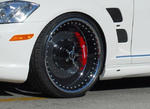
PICCHIO DAYTONA PROTOTYPE Ancarno, 15 February 2007 Picchio has completed the first feasibility studies for its new Daytona Prototype, and is going to install a body derived from the Alfa Romeo 8C Competizione on its in-house developed Grand Am-compliant tubular chassis Picchio proposes on one's own initiative this solution, as a consequence of the changes in the Grand Am Cup regulations: from 2008 to 2013 it will be possible to adopt a bodywork derived by an engine manufacturer. So, if Alfa Romeo wanted to homologate its 8V, at present installed on the 8C, the car could be identified as own of the engine manufactuer. According to Picchio, the shape of this possible Alfa sportscar fits perfectly into the DP2 chassis. The result is a highly emotional and lightweight car capable of
extreme performances ( for more informations you can see the specifications). The clean lines are the result of careful aerodynamic analysis, which could make this race car as well as beautiful, also a high competitive one; infact one of the research goals imposed by Grand Am regulations is to achieve the maximum aerodynamic downforce on the rear end, and the body shape of the Alfa 8C has very good qualities from this point of view. Today Picchio is the only European Manufacturer approved by Grand Am, which bars out the new constructors access to this series, by now vary successful.
In n. 003 chassis, soon to be completed, and in the n. 004 in the pipeline, Picchio did several changes in aerodynamics, chassis, bodywork, power plant and cockpit comfort engineering. The front aerodynamics has been modified in order to obtain a greater loading, even if the drag has been mantained to the same value. The water radiator has been also re-designed so to improve its performances. The rear aerodynamics has also been changed: the previous design was optimized to get a greater loading. The chassis has been re-designed to integrate the semi-stressed engine: this allowed to obtain record results of bending and roll stiffness, while the weight has even
been reduced, what the factory is very satisfied about. The engine-gearbox assembly now is 1 inch lower and the oil coolers have been put into the rear of the car. In the last designing work, the engineers put a special effort to clear heat flows from the engine compartment: the flows will be entirely channelled outside, with the result of significantly reducing the engine compartment temperature. The improvements made on front, rear and roof aerodynamics make both the pedal area and the cockpit cooler, getting a positive feedback on drivers’ performance during a race. The technical staff tried several types of shock absorbers out and so did with different suspension
assets, improving the roll and pitch behaviour. Every car will have the power steering installed. And from the style side they brought several changes: Picchio got so many improvement points (more than 100) to the DP2, that the car must be referred to as a new model, whose name will be DP3.
The DP2 n. 03 chassis
In the Picchio’s garages the n. 03 Picchio Daytona Prototype chassis has been almost completed. The car was designed complying with the Grand-Am regulation and has been built in 2002. Although the general structure is the same, as the regulation states, the engineering staff brought several significant improvements in order to have a further structure adjustment and
improve the accessibility and the driver-friendly side. The engine power plant to mount is still under decision of the tecnhical staff, even if the car is designed to have no problems in switching from one engine type to another, just by changing the connections between the engine points and the ones on the chassis. The third Daytona Prototype will be sold by next November.
DP2 engine
The engine systems candidate for installation on the next Picchio Daytona Prototypes are three. One of them is the V8 BMW engine, installed on the Picchio DP2 competing at the Grand-Am 2003 Championship, which demonstrated such a great reliability until now that even the factory is impressed. Furthermore, in United States persists a strong interest for the V8 Maserati engine. There are, though, also negotiations going on for a Toyota-engined Picchio, among whose engines the Lexus’ V8 4300 engine would be chosen. This engine, rather robust and of proven resistance, would be a great choice for endurance competitions like the USA ones. But if the choice may be difficult from the technical side, there is no problem for installation: whichever is the engine chosen, the Picchio maintains the possibility of mounting all the three engines on its chassis, by simply changing the connections between the engine junctures and the chassis ones. One of the advantages given by Picchio is actually the chassis flexibility and its manageability with the different power plants.
Last developments of new Daytona Prototype
The Daytona Prototype under construction in the factory’s workshop has now taken a nice yellow ‘Picchio colour’. The car has been just painted and some final elements have been added to the bodywork. In the new setup it’s also possible to see the new rear grids and the new air flow intake system in the front radiator. The next step is the installation of the new power plant, that will be soon delivered to the workshop, and then the technical staff will proceed to the first shakedown on the track. About the racing strategy, talks are currently going on with USA-based teams to take part to Grand-Am events in the late part of the Championship. The managers are also evaluating a possible participation with another Daytona Prototype car later on in the Championship. Picchio has come to specific agreements with some Italian drivers too, who will have a seat in the car.










